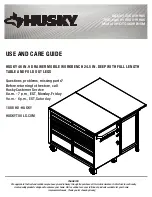
Weights, dimensions and component CG measurements
Cabinet CG dimensions are reported as measured from the inside bottom of the cabinet (Z), the
leading edge of the vertical mounting rails (Y), and the centerline of the cabinet mounting space
(X). Component CG measurements are measured from the bottom of the U space the component
is to occupy (Z), the mounting surface of the mounting flanges (Y), and the centerline of the
component (X).
Determining the CG of a configuration may be necessary for safety considerations. CG
considerations for CG calculations do not include cables, PDU’s and other peripheral components.
Some consideration should be made to allow for some margin of safety when estimating
configuration CG.
Estimating the configuration CG requires measuring the CG of the cabinet the product will be
installed in. Use the following formula:
Σd
component
W = d
system cg
W
where d
component
= the distance of interest and W = Weight
The distance of a component is its CG’s distance from the inside base of the cabinet. For example,
if a loaded disk enclosure is to be installed into the cabinet with its bottom at 10U, the distance
for the enclosure would be (10*1.75)+2.7 inches.
Airflow and Recirculation
Component Airflow Requirements
Component airflow must be directed from the front of the cabinet to the rear. Components vented
to discharge airflow from the sides must discharge to the rear of the cabinet.
Rack Airflow Requirements
The following requirements must be met to ensure adequate airflow and to prevent damage to the
equipment:
•
If the rack includes closing front and rear doors, allow 830 square inches (5,350 sq cm) of
hole evenly distributed from top to bottom to permit adequate airflow (equivalent to the required
64 percent open area for ventilation).
•
For side vented components, the clearance between the installed rack component and the
side panels of the rack must be a minimum of 2.75 inches (7 cm).
•
Always use blanking panels to fill all empty front panel U-spaces in the rack. This ensures
proper airflow. Using a rack without blanking panels results in improper cooling that can lead
to thermal damage.
Configuration Standards
EVA configurations are designed considering cable length, configuration CG, serviceability and
accessibility, and to allow for easy expansion of the system. If at all possible, it is best to configure
non HP cabinets in a like manner.
UPS Selection
This section provides information that can be used when selecting a UPS for use with the EVA. The
four HP UPS products listed in
Table 25 (page 197)
are available for use with the EVA and are
included in this comparison.
Table 26 (page 197)
identifies the amount of time each UPS can sustain
power under varying loads and with various UPS ERM (Extended Runtime Module) options.
NOTE:
The specified power requirements reflect fully loaded enclosures (14 disks).
196
Non-standard rack specifications
Summary of Contents for EVA P6000
Page 187: ...German laser notice Italian laser notice Japanese laser notice Laser compliance notices 187 ...
Page 193: ...German battery notice Italian battery notice Battery replacement notices 193 ...
Page 194: ...Japanese battery notice Spanish battery notice 194 Regulatory compliance notices ...
















































